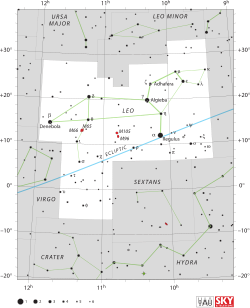59 Leonis
59 Leonis, som är stjärnans Flamsteed-beteckning, är en ensam stjärna,[10] belägen i den södra delen av stjärnbilden Lejonet och har även Bayer-beteckningen c Leonis. Den har en skenbar magnitud av ca 4,98[2] och är svagt synlig för blotta ögat där ljusföroreningar ej förekommer. Baserat på parallaxmätning inom Hipparcosuppdraget enligt på ca 21,6[1] mas, beräknas den befinna sig på ett avstånd på ca 151 ljusår (ca 46 parsek) från solen. Den rör sig närmare solen med en heliocentrisk radialhastighet på ca -12 km/s.[5]
| 59 Leonis | |
 | |
| Observationsdata Epok: J2000.0 | |
|---|---|
| Stjärnbild | Lejonet |
| Rektascension | 11t 00m 44,80142s[1] |
| Deklination | +06° 06′ 05,2093″[1] |
| Skenbar magnitud () | +4,98 (V)[2] |
| Stjärntyp | |
| Spektraltyp | A5 III[3] eller A6 IV[4] |
| B–V | +0,166 ± 0,005[2] |
| Astrometri | |
| Radialhastighet () | -11,7 ± 1,3[5] km/s |
| Egenrörelse (µ) | RA: -52,73[1] mas/år Dek.: -23,23[1] mas/år |
| Parallax () | 21,57 ± 0,26[1] |
| Avstånd | 151 ± 2 lå (46,4 ± 0,6 pc) |
| Absolut magnitud () | 1,65[2] |
| Detaljer | |
| Massa | 1,73[6] M☉ |
| Radie | 2,26[7] R☉ |
| Luminositet | 18,27[2] L☉ |
| Temperatur | 8 277 ± 281[6] K |
| Vinkelhastighet | 82[8] km/s |
| Ålder | 332[6] miljoner år |
| Andra beteckningar | |
| c Leo, 59 Leo, AG+06 1381, BD+06 2384, CCDM J11007+0606A, GSC 00268-01064, HD 95382, HIC 53824, HIP 53824, HR 4294, 2MASS J11004483+0606054, PLX 2565, PPM 157421, SAO 118615, TD1 15299, TYC 268-1064-1 uvby98 100095382, WDS J11007+0606A, Gaia DR2 3816629714434106752 [9] | |
Egenskaper
redigera59 Leonis är en vit till blå jättestjärna av spektralklass A5 III[3] eller A6 IV[4] beroende på osäkerhet om tolkningen av stjärnans färg.[11] Den har en massa som är ca 1,7[6] solmassor, en radie som är ca 2,3[7] solradier och utsänder från dess fotosfär ca 18[2] gånger mera energi än solen vid en effektiv temperatur av ca 8 300[6] K.
Referenser
redigera- Den här artikeln är helt eller delvis baserad på material från engelskspråkiga Wikipedia, 59 Leonis, 5 april 2020.
Noter
redigera- ^ [a b c d e f] van Leeuwen, F. (2007), "Validation of the new Hipparcos reduction", Astronomy and Astrophysics, 474 (2): 653–664, arXiv:0708.1752, Bibcode:2007A&A...474..653V, doi:10.1051/0004-6361:20078357.
- ^ [a b c d e f] Anderson, E.; Francis, Ch. (2012), "XHIP: An extended hipparcos compilation", Astronomy Letters, 38 (5): 331, arXiv:1108.4971, Bibcode:2012AstL...38..331A, doi:10.1134/S1063773712050015.
- ^ [a b] Cowley, A.; et al. (April 1969), "A study of the bright A stars. I. A catalogue of spectral classifications", Astronomical Journal, 74: 375–406, Bibcode:1969AJ.....74..375C, doi:10.1086/110819
- ^ [a b] Gray, R. O.; Garrison, R. F. (July 1989), "The Late A-Type Stars: Refined MK Classification, Confrontation with Stroemgren Photometry, and the Effects of Rotation", Astrophysical Journal Supplement, 70: 623, Bibcode:1989ApJS...70..623G, doi:10.1086/191349.
- ^ [a b] de Bruijne, J. H. J.; Eilers, A.-C. (October 2012), "Radial velocities for the HIPPARCOS-Gaia Hundred-Thousand-Proper-Motion project", Astronomy & Astrophysics, 546: 14, arXiv:1208.3048, Bibcode:2012A&A...546A..61D, doi:10.1051/0004-6361/201219219, A61.
- ^ [a b c d e] David, Trevor J.; Hillenbrand, Lynne A. (2015), "The Ages of Early-Type Stars: Strömgren Photometric Methods Calibrated, Validated, Tested, and Applied to Hosts and Prospective Hosts of Directly Imaged Exoplanets", The Astrophysical Journal, 804 (2): 146, arXiv:1501.03154, Bibcode:2015ApJ...804..146D, doi:10.1088/0004-637X/804/2/146.
- ^ [a b] https://www.universeguide.com/star/59leonis. Hämtad 2020-04-05.
- ^ Royer, F.; et al. (October 2002), "Rotational velocities of A-type stars in the northern hemisphere. II. Measurement of v sin i", Astronomy and Astrophysics, 393: 897–911, arXiv:astro-ph/0205255, Bibcode:2002A&A...393..897R, doi:10.1051/0004-6361:20020943.
- ^ "59 Leo". SIMBAD. Centre de données astronomiques de Strasbourg. Hämtad 2020-04-05.
- ^ De Rosa, R. J.; et al. (2014), "The VAST Survey - III. The multiplicity of A-type stars within 75 pc", Monthly Notices of the Royal Astronomical Society, 437 (2): 1216, arXiv:1311.7141, Bibcode:2014MNRAS.437.1216D, doi:10.1093/mnras/stt1932.
- ^ Hauck, B. (February 1986), "Metallicism among A and F giant stars", Astronomy and Astrophysics, 155: 371−379, Bibcode:1986A&A...155..371H.



